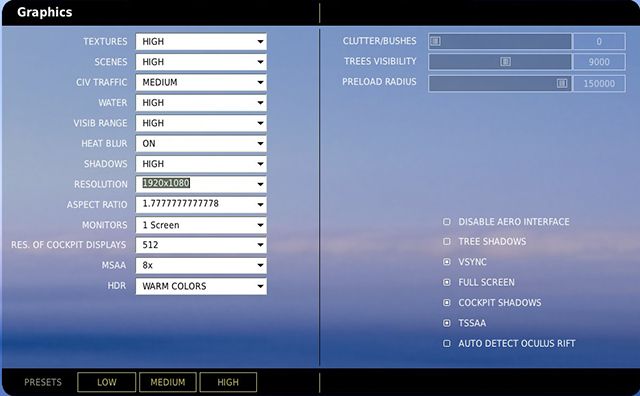-
Posts
1793 -
Joined
-
Last visited
Content Type
Profiles
Forums
Events
Posts posted by Corrigan
-
-
Also bear in mind that nvidia control panel settings can have a big impact!
-
No, my CPU is´nt overclocked.
Here are my settings - forgot to attach them in the previous posting:

Wow, TSSAA? Try turning that off.
-
I'd expect more from your system, but all that info is kinda incomplete without mentioning resolution.
Also, is your CPU overclocked?
-
Saw that pic on Reddit. There's something iffy about it. Look at the top of the HUD frame, looks like a cut-and-paste job.
-
Even the DCS manual speaks of "altitudes above 18000 m" on p. 33. So I tried getting there.
My setup: clean aircraft, starting with as little fuel I dared (25%), no gun ammo. Default mission editor atmospherics.
I used reheat literally all the time, trying to zoom climb. I got to 15 000 m, but here I couldn't get past 450 km/h IAS in full afterburner in even flight, so I had nothing with which to zoom. Now I had only 350 L or so left, so I made a valiant attempt to convert the last of my airspeed and fuel to altitude.
Flying on fumes, I finally stalled at about 16 600 m.
Something is clearly very wrong with the service ceiling as well.
Track is attached.
EDIT: I also tried a quick test with the "Simplified engine management" option checked: no difference.
-
Out of curiosity, seems that 15km is the f-16 service ceiling. Go figure!
Are you saying the MiG shouldn't be able to fly there?
Table 3, p. 12 in this manual has descent data from 18 km.
Or am I misunderstanding you? :)
-
It was a shadow passing them. You can't see the backlighting in direct light.
-
I'm waiting to buy my next when their mainline cards utilize 6GB. It's close! I don't want to buy another two Titans..lol Though 24GB total VRAM would be nice for my work station
If I tell Nvidia you sent me, what will they do for me?
-
So how can I confirm this? How do I fix it?
Well, you can perhaps show us a track where you don't ever move the stick to it's full extent. Try flying for a minute only using half of the available travel in every direction. If you don't have any trouble doing this, I think we can conclude that your controls are set up properly.
-
Here's a track which I find problematic:
I have 60% internal fuel, the small centreline tank and 2 R3Rs. I start at about 10000 m, immediately go into Recovery mode, and use reheat up to about 500 km/s IAS. I then come out of reheat and just wait. After like 3-4 mins I'm down to 410 IAS, 12 deg AoA. Shortly after I start to lose altitude.
The track ends about 7 mins after I started with me doing 370 km/h IAS, at 9500 m and falling, still in recovery mode.
Clearly, it's not possible to cruise in this configuration at this altitude. The question then is, should it be? I'd that everything I've read indicates yes.
-
That's what I am trying to ascertain here - I always presume that there is indeed something wrong (why else would someone bother to report it?) even though it does not necessarily accord with my findings, which is why I try to replicate member findings and post my own results. Doing so highlights my failures and possible those of others and helps me better understand exactly what the issue is and how to report it.
In this specific instance there is as of yet too many unknowns, test aircraft parameters being but one. I definitely feel as if the service ceiling is way too low at present but then again that's just a feeling. Have not tested specifically - still hung up on the cruise speed at altitude allegation at present :)
Well, like I said before, I think we all appreciate the time.
Getting back to your 10500 m cruising track: again, I worry about your fuel load. You're at 800 L even before you drop to 10000 m. The aircraft isn't tactically useful. I worry that it's an unrealistic scenario.
-
So, Viper, can I ask your impression? Do you think there's something wrong with the flight model? Or are you not convinced? Or do you think there's a slight problem but it's being exaggerated?
-
And as I mentioned, just after you start the climb, Viper, you're doing 930 TAS. Again, not to be a dick, but I think you would have done much worse if you had stuck to the manual's prescription.
-
OK just checked:
Commenced climb at 12:01:35 and reached 10 000m AGL at 12:11:10.
9 min 35 seconds.
Yeah, but it should take you just under that to 11000, which instead takes you 13 minutes.
-
What we are lacking in this discussion are specific climb profiles.
I agree. Although if you look at the last part of my post which I just edited in, it's clear that the climb the manual is talking about is much much faster than the ones we can do (including your track).
-
Quick question: how does one access the flight recorder data?
Watching your track now, Viper. Really not trying to be a dick here, but you start climbing at much more than 870 km/h TAS (as per the manual). I imagine that's what makes the difference.
Also, if you look at the track, you can see that you weren't actually able to hold a steady climb at that airspeed. Looks to me (as a layman) like a series of zoom climbs. But maybe the manual takes some of that into account? I'm not very experienced with technical literature in this field.
EDIT: Also, you have a much lighter aircraft than the other tests, looks like 1800 L of fuel. Not 100% sure what the manual refers to, but it doesn't really make sense to take off in a short-range interceptor with half fuel.
Regardless of fuel state, the manual says a climb like the one you did, or tried to perform, should take 8:50, and I think yours took 14-15 mins.
-
I think that's intended. I have vivid memories of hearing PULL UPP, PULL UP in the A-10 while watching something else in external view, at least.
EDIT: then again, the low altitude warning in the MiG-21 isn't audible in F2 view, so it's a bit inconsistent.
-
Thanks for the help btw, Viper.
-
You have different-weighing aircraft, surely.
-
Referring to me?
-
I think maybe we should talk about this table. First of all, does anyone have an alternate flight manual? I think this is a good time to try to look at a second trustworthy source.
Also, doesn't anyone else see a problem with this chart?
http://i.imgur.com/WsJ8TBf.jpg
Take the 7000 m clean climb as an example. I'll quote myself:
EDIT 2
What am I missing with that table? How can they possibly get 40 km? If you fly 870 km/h TRUE AIRSPEED for about 4 mins you'll have moved 870*4/60 km = 58 km through the airmass. Since you're only 7 km up at the end, you have basically the same distance across the ground too. I don't understand how they've found 40 km. Is there some definitional matter I'm missing or a term I'm misunderstanding?
-
Well, whatever scale SARPP uses I don't think we can read too much into it.
-
Isn't it stange by the way that the SARPP reports 90% RPM, while we have almost 100% indicated (needle 1) at full power?
When we talked about that earlier I just assumed that the SARPP uses another scale, not "physical" RPM but rather power output normalized to unity. Then again, is it reasonable that reheat adds ~10% power on top of military? I dunno.
-
Looks really pretty! Well done.




Taxiing, brakes, rudder - how does it work (technically)?
in MiG-21Bis
Posted
It can't possibly be aerodynamics, that would be utterly unphysical.
I was also surprised at what you're talking about. I assume that giving rudder input actually differentially brakes the undercarriage, but I'm not sure that it's working as intended. Was, like you, expecting having to brake with the lever and simultaneously give rudder to get ANY turning at all.